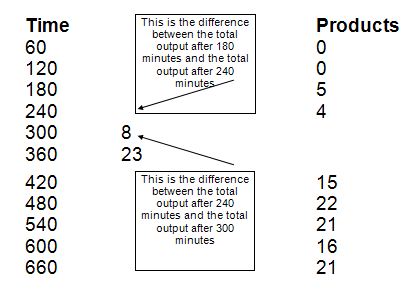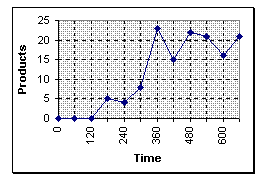Warm Up Time
You may need to find a suitable 'run-in' or 'warm-up' time for your simulation. Simulations of factories usually need a warm-up time because your simulation is likely to start empty (no products at any of the machines), but real factories do not start each week without any work-in-progress! A situation where you would not need a warm-up time in a simulation might be when you are simulating the start up of a new factory, where you happen to be interested in its first day's operations, or where you are simulating a situation that starts each day empty: like a shop, or a car park, or an airport. However, even in these circumstances you would probably want to separate off the results you get during the early part of the day from the results under peak conditions because knowing the 'average' performance of an operation that never works under 'average' conditions is probably not worthwhile.
Most simulation packages contain facilities to set a 'warm-up' time, during it results are either not collected, or can be separated off from the main results collection time.
But how to you decide how long to make the warm-up time? There is a simple procedure for this.
1. Decide what measures of performance are of interest to you
For example you might be interested in the number of products leaving the factory, or the utilization of a machine or the length of a Queue. If there is more than one then you might want to carry out this procedure for some, or all, of the measures that interest you and use the longest warm-up time indicated. Lets just assume you are interested in the number of products leaving the factory.
2. Run the simulation for a short period of time
The amount of time you run the simulation for is rather dependent on what you are simulating but if the total time you wanted to run the simulation for was, say, a week (see below for how to decide this) then you might make this “short period of time” an hour. It needs to be an amount of time in that you might expect to get a few products out of the factory. Anyway, having run the simulation for, say, 60 minutes, record the number of products that have emerged from the factory. This will almost certainly be zero for the first 60 minutes! This is because of the nature of the need for a warm-up time. No products will have reached the end of the factory yet!
3. Run the simulation again
Run the simulation for another 60 minutes (or whatever time you have chosen) and record how many products left the factory in the second 60 minute period. i.e. the number that emerged between 60 and 120 minutes - not the total at the end of 120. Keep doing this and you should end up with a table looking something like this:

that you could plot in a chart to make it easy to see what is happening:

If you plot the chart as you collect the numbers you will be able to see when you have gone far enough. In the example above we can see (by the time we get to simulated time 660) that there is a fairly distinct difference between the figures prior to time 360 and the figures after time 360. So before time 360 the simulation was still 'warming up'.
Obviously you will not expect a completely steady line after time 360 because simulation matches reality - and you cannot expect completely steady output from a real factory. The simulation is using random numbers (mentioned above) to emulate the variability in the real world (e.g. for the time a machine takes to weld each box), so you would expect some variability in output. There might be some variability even if the simulation contained no randomness. This will be discussed later.
This example has been deliberately made clearer than often occurs. Quite often the performance measure that you are interested never looks at-all stable. Sometimes during the warm-up time the measure you are interested in is very high, sometimes it is very stable - and becomes unstable once the simulation has warmed up.
You will have to make a judgment when you look at the figures (and a graph) about how much warm-up time to allow. The principle is simply to ensure that the simulation is not in some atypical start-up state caused by the simulation starting empty.
4. Define safety margin
Once you have determined a warm-up time it is worth adding about 20% to it as a safety margin and then using this warm-up time for all your analysis of the simulation unless the structure of the simulation, or the data in it, gets changed significantly. Strictly speaking you ought to recheck the warm up time every time you change anything in the simulation (even the random number streams) - but in practice this would take more time than is usually available! The only harm in making the warm-up time too long is that it can take up a lot of your time when you are running the model.
Significant changes to the simulation might affect how long it would take to warm-up, so you might need to repeat the above process.